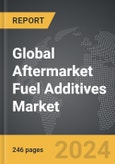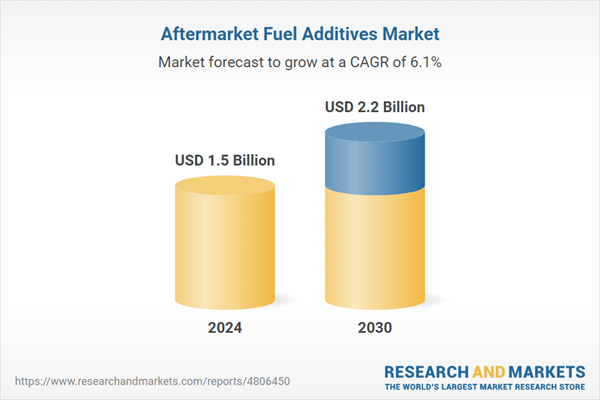The global market for Aftermarket Fuel Additives was valued at USD 1.5 Billion in 2024 and is projected to reach USD 2.2 Billion by 2030, growing at a CAGR of 6.1% from 2024 to 2030. This comprehensive report provides an in-depth analysis of market trends, drivers, and forecasts, helping you make informed business decisions.
Global Aftermarket Fuel Additives Market - Key Trends & Drivers Summarized
Why Are Aftermarket Fuel Additives Important for Vehicle Maintenance?
Aftermarket fuel additives play a critical role in enhancing the performance and longevity of internal combustion engines. These additives, typically mixed with gasoline or diesel, help to clean fuel injectors, reduce engine deposits, improve fuel economy, and reduce harmful emissions. As modern engines become more sophisticated and environmental regulations around emissions tighten, the demand for high-quality aftermarket fuel additives is increasing. Additives designed to improve fuel efficiency, restore engine performance, and prolong the lifespan of automotive components are becoming essential for vehicle owners, especially in regions where fuel quality may vary or where vehicles face harsh driving conditions.How Are Environmental Regulations Shaping the Demand for Fuel Additives?
The push for cleaner air and lower emissions is one of the major drivers of growth in the aftermarket fuel additives market. Governments around the world are implementing stricter emissions regulations, forcing both vehicle manufacturers and consumers to adopt solutions that reduce their environmental footprint. Fuel additives that reduce particulate emissions, prevent buildup of engine deposits, and enhance combustion efficiency are increasingly in demand as a result. The rising awareness of climate change and air pollution, particularly in regions with large vehicle populations, is also prompting consumers to invest in additives that improve fuel efficiency and reduce their carbon output, while also helping vehicles meet emissions standards.How Is the Automotive Industry Adapting to Changing Fuel Additive Needs?
As vehicles become more technologically advanced, the need for specialized fuel additives has grown. Modern engines, especially those in high-performance vehicles and diesel-powered trucks, require additives that maintain fuel system cleanliness, prevent corrosion, and optimize performance. The automotive industry is responding to this demand by developing additives tailored to specific engine types, such as direct fuel injection systems, hybrid engines, and diesel particulate filters (DPFs). With fuel formulations also evolving to meet environmental standards, additives that work in conjunction with cleaner fuels, such as ethanol blends and biodiesel, are gaining popularity. Additionally, as vehicle owners seek to maximize the lifespan of their investments, fuel additives are increasingly marketed as cost-effective solutions for maintaining engine health.What Is Driving Growth in the Aftermarket Fuel Additives Market?
The growth in the aftermarket fuel additives market is driven by several factors, including rising vehicle ownership, the increasing awareness of fuel economy and emissions control, and advancements in fuel technology. As consumers become more conscious of environmental impacts and fuel costs, additives that promise improved fuel efficiency and lower emissions are seeing greater adoption. Furthermore, the growing number of older vehicles on the road, combined with the desire to prolong their operational lifespan, is boosting demand for additives that clean fuel systems and restore engine performance. The ongoing development of more sophisticated, specialized additives designed for modern engines and alternative fuels is also contributing to the market's growth trajectory.Report Scope
The report analyzes the Aftermarket Fuel Additives market, presented in terms of market value (USD Thousand). The analysis covers the key segments and geographic regions outlined below.Segments
Application (Gasoline, Diesel); Distribution Channel (Big Stores, 4S Stores, Unauthorized Centers, Gas Stations, Other Distribution Channels).Geographic Regions/Countries
World; United States; Canada; Japan; China; Europe (France; Germany; Italy; United Kingdom; Spain; Russia; and Rest of Europe); Asia-Pacific (Australia; India; South Korea; and Rest of Asia-Pacific); Latin America (Argentina; Brazil; Mexico; and Rest of Latin America); Middle East (Iran; Israel; Saudi Arabia; United Arab Emirates; and Rest of Middle East); and Africa.Key Insights:
- Market Growth: Understand the significant growth trajectory of the Gasoline Fuel segment, which is expected to reach $1.4 Billion by 2030 with a CAGR of a 5.2%. The Diesel Fuel segment is also set to grow at 7.8% CAGR over the analysis period.
- Regional Analysis: Gain insights into the U.S. market, valued at $399.6 Million in 2024, and China, forecasted to grow at an impressive 8.8% CAGR to reach $491.6 Million by 2030. Discover growth trends in other key regions, including Japan, Canada, Germany, and the Asia-Pacific.
Report Features:
- Comprehensive Market Data: Independent analysis of annual sales and market forecasts in USD from 2024 to 2030.
- In-Depth Regional Analysis: Detailed insights into key markets, including the U.S., China, Japan, Canada, Europe, Asia-Pacific, Latin America, Middle East, and Africa.
- Company Profiles: Coverage of major players such as Afton Chemical Corporation, Ashland, Inc., BASF SE, BG Products, Inc., Chevron Oronite Company LLC and more.
- Complimentary Updates: Receive free report updates for one year to keep you informed of the latest market developments.
Why You Should Buy This Report:
- Detailed Market Analysis: Access a thorough analysis of the Global Aftermarket Fuel Additives Market, covering all major geographic regions and market segments.
- Competitive Insights: Get an overview of the competitive landscape, including the market presence of major players across different geographies.
- Future Trends and Drivers: Understand the key trends and drivers shaping the future of the Global Aftermarket Fuel Additives Market.
- Actionable Insights: Benefit from actionable insights that can help you identify new revenue opportunities and make strategic business decisions.
Key Questions Answered:
- How is the Global Aftermarket Fuel Additives Market expected to evolve by 2030?
- What are the main drivers and restraints affecting the market?
- Which market segments will grow the most over the forecast period?
- How will market shares for different regions and segments change by 2030?
- Who are the leading players in the market, and what are their prospects?
Some of the 46 major companies featured in this Aftermarket Fuel Additives market report include:
- Afton Chemical Corporation
- Ashland, Inc.
- BASF SE
- BG Products, Inc.
- Chevron Oronite Company LLC
- Infineum International Ltd.
- Lucas Oil Products, Inc.
- The Lubrizol Corporation
- Total SA
Table of Contents
I. METHODOLOGYII. EXECUTIVE SUMMARY2. FOCUS ON SELECT PLAYERSIII. MARKET ANALYSISSOUTH KOREAREST OF ASIA-PACIFICARGENTINABRAZILMEXICOREST OF LATIN AMERICAIRANISRAELSAUDI ARABIAUNITED ARAB EMIRATESREST OF MIDDLE EASTIV. COMPETITION
1. MARKET OVERVIEW
3. MARKET TRENDS & DRIVERS
4. GLOBAL MARKET PERSPECTIVE
UNITED STATES
CANADA
JAPAN
CHINA
EUROPE
FRANCE
GERMANY
ITALY
UNITED KINGDOM
SPAIN
RUSSIA
REST OF EUROPE
ASIA-PACIFIC
AUSTRALIA
INDIA
LATIN AMERICA
MIDDLE EAST
AFRICA
Companies Mentioned (Partial List)
A selection of companies mentioned in this report includes, but is not limited to:
- Afton Chemical Corporation
- Ashland, Inc.
- BASF SE
- BG Products, Inc.
- Chevron Oronite Company LLC
- Infineum International Ltd.
- Lucas Oil Products, Inc.
- The Lubrizol Corporation
- Total SA
Table Information
| Report Attribute | Details |
|---|---|
| No. of Pages | 246 |
| Published | April 2025 |
| Forecast Period | 2024 - 2030 |
| Estimated Market Value ( USD | $ 1.5 Billion |
| Forecasted Market Value ( USD | $ 2.2 Billion |
| Compound Annual Growth Rate | 6.1% |
| Regions Covered | Global |









